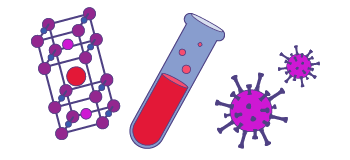MALDI, a method of ionization that has been widely used since its introduction in the late 1980s, has been of great help to scientists studying polymers, proteins and other heavy molecules. This is how it works.

Let’s say you have a sample of some protein and need to find out what molecules it’s made of, and about how many of each. Your first step is to dissolve your sample. Then you mix that solution with a special substance (the exact composition of which depends on your experiment). The two key features of this special substance is that it is lightweight (in contrast to the heavy sample molecules), and that it readily absorbs ultraviolet light. (Most MALDI uses UV light, but there are applications of infrared light as well, used with different matrices that absorb the IR.) Next, you need to turn that liquid (containing your protein) back into a solid, which is accomplished by putting it in a vacuum chamber. Removing air from the chamber causes the solvent to evaporate, leaving behind what’s called a matrix, a crystal lattice in which bits of the protein have been incorporated. So what you have is like a plate of scrambled eggs (the matrix) sprinkled with just a pinch of salt (the sample molecules, or analytes. (In fact, the proportion of analyte to matrix is even smaller in an actual MALDI sample – as small as 100 parts per million).
Next, a laser is trained on the matrix. The result is not unlike a meteor hitting a planet – albeit on a much smaller scale. The molecules (from both the sample and the matrix) are vaporized, shooting off the surface. The matrix material absorbs the energy of the laser’s photons, and becomes ionized in the process. The material passes along that UV energy to the vaporized protein molecules, some of which in turn are ionized. Studies continue to focus on the exact mechanism(s) at work, but essentially the collisions between the matrix molecules and the sample molecules result in a kind of mid-air chemical ionization.
This matrix serves as a kind of buffer between the fragile protein (which you don’t want to damage) and the powerful laser. If there had been no matrix to serve as an intermediary – that is, if a pure sample of the protein had been exposed to the laser – the molecules would have broken apart, rendering the sample useless.
After the analyte molecules are ionized, they are drawn from the evaporation chamber into the MS by the voltage applied across the chamber. Although many matrix ions also make it to the MS, they are so much lighter than the heavy sample ions that there is no risk of getting the two confused, and it’s easy to weed them out of the results.

Explore our magnet schedule to see what exciting research is happening on our stellar fleet of instruments right now.
Last modified on 08 August 2023